Search results for: 'Römische Zeit'
-
 Roman knee brooch
Roman knee broochPrime example of this important and popular type of brooch during the 2nd century.
Price: on request Römische Scheibenfibel in Millefiori-Technik
Römische Scheibenfibel in Millefiori-TechnikKunstvolle Fibel aus der Kaiserzeit. Großartiges Beispiel für die antike Millefiori-Technik, die erst wieder in der Neuzeit aufgegriffen und von venezianischen Glaskünstlern zu einer neuen Blüte geführt wurde.
Price: on request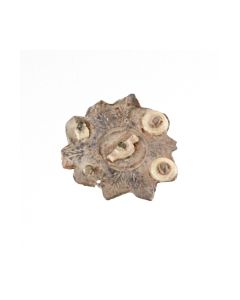 Elaborate Roman plate brooch
Elaborate Roman plate broochTen pointed star form with leaf pattern and decorative buttons. A product of Gaul or Britain dating to the 1st century.
Price: on request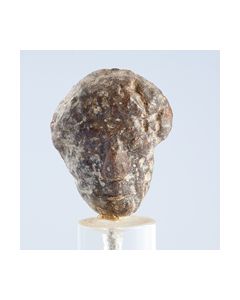 Kleiner Kopf aus Blei
Kleiner Kopf aus BleiHohlplastik eines männlichen Kopfes aus Blei, mit Frisur aus der Zeit der Adoptivkaiser,
Price: on request Kleiner Kopf aus Blei
Kleiner Kopf aus BleiHohlplastik eines männlichen Kopfes aus Blei, mit Frisur aus der Zeit der Adoptivkaiser,
Price: on request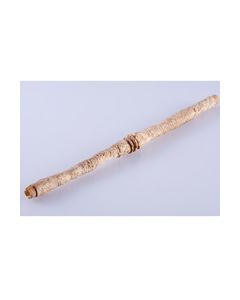 Großes Objekt aus Bein
Großes Objekt aus BeinRömisch. Möglicherweise Teil einer Nadel. 16cm lang. Vermutlich aus CUT.
Price: on request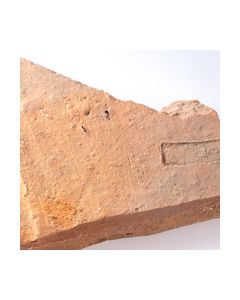 Fragment of a stamped Roman tile
Fragment of a stamped Roman tileProbably manufactured in Treves area, Germany. Roman Empire, 3rd - 4th century A.D.
Price: on request Roman discus fibula with color glass paste
Roman discus fibula with color glass pasteSpannende Fibel mit Sterndekor und Glaspaste. Eine Weiterentwicklung keltischen Kunsthandwerks in der Zeit römischer Herrschaft. Gut dokumentierter Typ aus dem 2. Jh. v. Chr. mit Verbreitung in weiten Teilen Europas.
Price: on request Enameled Galo-Roman fibula
Enameled Galo-Roman fibulaGrundform einer rechteckigen Platte, erweitert durch Zierknopf an Kopf- und Fußende. Drei Paare von Dreiecken auf der Platte sind durch weiße Einlagen hervorgehoben. Etwa 2. Jh. n. Chr.
Price: on request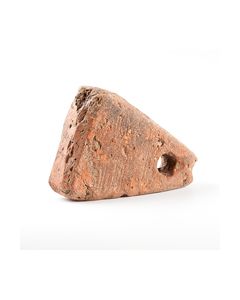 Roman clay loom weight
Roman clay loom weightMassives Gewicht aus Terrakotta mit Öse zur Aufhängung als Webgewicht, aus der römischen Kaiserzeit, Germanische Provinzen, 1. bis 2. Jh. n. Chr.
Price: on request Roman sandal sole type fibula
Roman sandal sole type fibulaDie Form wird in der Literatur als Schuh- oder Sandalensohle bezeichnet. Der sehr dekorative Fibeltyp war extrem beliebt und im zweiten Jahrhundert weit verbreitet. Er stammt aus den nördlichen römischen Provinzen.
Price: on request Großer römischer Teller
Großer römischer TellerBackplatte oder Servierplatte. Imitierte Pompejanisch-rote Keramik aus dem 2. bis 3. Jh. n. Chr. Provinzen Germania. 55cm Durchmesser, 9kg. schwer. Inklusive TL-Gutachten.
Price: on request Published Roman fibula with celtic design
Published Roman fibula with celtic designAncient fibula from the Roman province of Britain. The design can be attributed to the celtic tribe of the Trinovantes or Iceni. From the famous Hattatt collection. Published twice.
Price: on request Base of a Jupiter Column
Base of a Jupiter ColumnRepeatedly published base of a Jupiter Column from the Roman province Germania superior. Mid 2nd century AD to mid 3rd century AD. With extensive provenance going back to the 17th century.
€15,000 Fragment of a stamped Roman tile
Fragment of a stamped Roman tileThe stamp AYK is not discussed in the literature at hand and thus may be rare.
Price: on request Große Gruppe römischer Tonziegel, meist gestempelt
Große Gruppe römischer Tonziegel, meist gestempelt2012 aus dem Privatbesitz T. Bak erworben, an welchen in dritter Familiengeneration die Sammlung von Professor Josef Lambinet übergegangen ist. Nach Angaben und Dokumenten von Prof. Lambinet wurden die Objekte um 1920 in Mainz gefunden, unmittelbar an der römischen Wasserleitung Mainz-Zahlbach.
Price: on request

